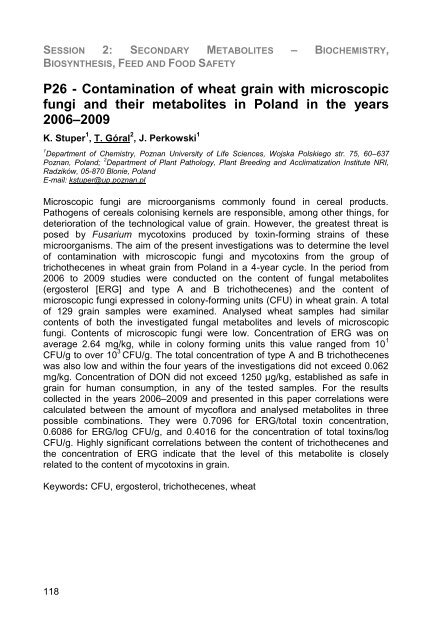EFS12- Book of abstracts - Contact
EFS12- Book of abstracts - Contact
EFS12- Book of abstracts - Contact
You also want an ePaper? Increase the reach of your titles
YUMPU automatically turns print PDFs into web optimized ePapers that Google loves.
SESSION 2: SECONDARY METABOLITES – BIOCHEMISTRY,<br />
BIOSYNTHESIS, FEED AND FOOD SAFETY<br />
P26 - Contamination <strong>of</strong> wheat grain with microscopic<br />
fungi and their metabolites in Poland in the years<br />
2006–2009<br />
K. Stuper 1 , T. Góral 2 , J. Perkowski 1<br />
1 Department <strong>of</strong> Chemistry, Poznan University <strong>of</strong> Life Sciences, Wojska Polskiego str. 75, 60–637<br />
Poznan, Poland; 2 Department <strong>of</strong> Plant Pathology, Plant Breeding and Acclimatization Institute NRI,<br />
Radzików, 05-870 Blonie, Poland<br />
E-mail: kstuper@up.poznan.pl<br />
Microscopic fungi are microorganisms commonly found in cereal products.<br />
Pathogens <strong>of</strong> cereals colonising kernels are responsible, among other things, for<br />
deterioration <strong>of</strong> the technological value <strong>of</strong> grain. However, the greatest threat is<br />
posed by Fusarium mycotoxins produced by toxin-forming strains <strong>of</strong> these<br />
microorganisms. The aim <strong>of</strong> the present investigations was to determine the level<br />
<strong>of</strong> contamination with microscopic fungi and mycotoxins from the group <strong>of</strong><br />
trichothecenes in wheat grain from Poland in a 4-year cycle. In the period from<br />
2006 to 2009 studies were conducted on the content <strong>of</strong> fungal metabolites<br />
(ergosterol [ERG] and type A and B trichothecenes) and the content <strong>of</strong><br />
microscopic fungi expressed in colony-forming units (CFU) in wheat grain. A total<br />
<strong>of</strong> 129 grain samples were examined. Analysed wheat samples had similar<br />
contents <strong>of</strong> both the investigated fungal metabolites and levels <strong>of</strong> microscopic<br />
fungi. Contents <strong>of</strong> microscopic fungi were low. Concentration <strong>of</strong> ERG was on<br />
average 2.64 mg/kg, while in colony forming units this value ranged from 10 1<br />
CFU/g to over 10 3 CFU/g. The total concentration <strong>of</strong> type A and B trichothecenes<br />
was also low and within the four years <strong>of</strong> the investigations did not exceed 0.062<br />
mg/kg. Concentration <strong>of</strong> DON did not exceed 1250 µg/kg, established as safe in<br />
grain for human consumption, in any <strong>of</strong> the tested samples. For the results<br />
collected in the years 2006–2009 and presented in this paper correlations were<br />
calculated between the amount <strong>of</strong> myc<strong>of</strong>lora and analysed metabolites in three<br />
possible combinations. They were 0.7096 for ERG/total toxin concentration,<br />
0.6086 for ERG/log CFU/g, and 0.4016 for the concentration <strong>of</strong> total toxins/log<br />
CFU/g. Highly significant correlations between the content <strong>of</strong> trichothecenes and<br />
the concentration <strong>of</strong> ERG indicate that the level <strong>of</strong> this metabolite is closely<br />
related to the content <strong>of</strong> mycotoxins in grain.<br />
Keywords: CFU, ergosterol, trichothecenes, wheat<br />
118
















![Présentation CRB-anim [Mode de compatibilité] - Inra](https://img.yumpu.com/17418636/1/190x135/presentation-crb-anim-mode-de-compatibilite-inra.jpg?quality=85)